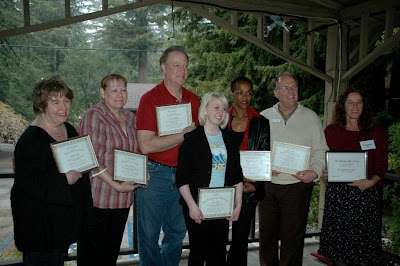
Guest Blogger:
Ben Whiting! Read part 1 of Boating Techniques
here.
In my last post I talked about varying the tension in your story. This time I want to examine a couple of examples in Harper Lee's classic,
To Kill a Mockingbird, to find some concrete ways of doing that.
One way to increase or decrease the tension in a scene is to control the distance. As with our speedboat example, the further the reader is from the story, the less tension he or she will feel. When you bring the skier in close, the rope will be tauter even if the boat's actual speed is the same. Read the following example, paying attention to the distance and accompanying tension.
The remainder of my schooldays were no more auspicious than the first. Indeed, they were an endless Project that slowly evolved into a Unit, in which miles of construction paper and wax crayon were expended by the State of Alabama in its well-meaning but fruitless efforts to teach me Group Dynamics. What Jem called the Dewey Decimal System was school-wide by the end of my first year, so I had no chance to compare it with other teaching techniques. I could only look around me: Atticus and my uncle, who went to school at home, knew everything—at least, what one didn't know the other did. Furthermore, I couldn't help noticing that my father had served for years in the state legislature, elected each time without opposition, innocent of the adjustments my teacher thought essential to the development of Good Citizenship.
This portion of the story summarizes a long period of time. We as readers are not immersed in the action, seeing each action and reaction as it occurs—instead, we are held at arm's length and allowed to view the school year as a whole. While the narrator's disagreement with her teacher's methods is a source of tension, the space between story and reader alleviates some of the suspense. Contrast that scene with this next one, in which she and Jem are headed home alone in the dark:
“Jem, you don't hafta—”
“Hush a minute, Scout,” he said, pinching me.
We walked along silently. “Minute's up,” I said. “Whatcha thinkin' about?” I turned to look at him, but his outline was barely visible.
“I thought I heard something,” he said. “Stop a minute.”
We stopped.
“Hear anything?” he asked.
“No.”
We had not gone five paces before he made me stop again.
“Jem, are you tryin' to scare me? You know I'm too old—”
“Be quiet,” he said, and I knew he was not joking.
The night was still. I could hear his breath coming easily beside me. Occasionally there was a sudden breeze that hit my bare legs, but it was all that remained of a promised windy night. This was the stillness before a thunderstorm. We listened.
Notice the difference? This scene magnifies the tension by drawing in close to the action, focusing on details instead of the big picture. If the scene was written in summary form instead, the tension in the rope holding us as readers would slacken considerably.
You may have noticed that the inherent intensity of the action in each of these scenes is different. Scout's disagreement with her teacher does not have as much potential for tension as a walk home at night with a strange man lurking in the darkness. This is because Harper Lee knew what she was doing. The focus should narrow in the most important scenes,
showing each individual action as it happens—
telling virtually nothing. When a scene is less important and has less natural tension, more things should be
told and fewer things
shown.
Another technique used in the second section that increases the tension is the brevity of the sentences and words. Dwight Swain says in his book,
Techniques of the Selling Writer, that the kind of writing and the words used are what convey tension to the reader. He advocates short words, sentences, and paragraphs to do this—“the tunnel vision that shuts out everything except the moment and the danger. The prolongation of crisis that stretches time like a rubber band.” The Harper Lee excerpts clearly illustrate this as well as the opposite—longer words, sentences, and paragraphs slow the pace down.
A final warning: varying the pace is good, but never
slow down enough to let the rope touch the water. If you do, you will lose all the tension in your scene, and—what's worse—you will probably lose your readers as well.
Ben Whiting
Using Fiction to Illustrate Truthhttp://twitter.com/benwhitingBen Whiting is a full-time English student at the University of Texas at Arlington and co-general editor of the award-winning collegiate publication Marine Creek Reflections. His current writing project, Penumbra, is a contemporary suspense novel that he hopes to finish over the summer.








